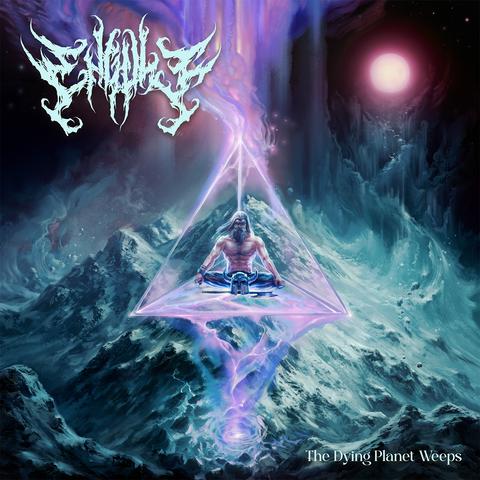Misanthropy – The Ever-Crushing Weight of Stagnance Review
By Kenstrosity
Apparently, Chicago progressive tech death quartet Misanthropy used to play thrash metal. Once I learned of this shift, it felt like I could suddenly hear a thrashy thread running through their newest release, The Ever-Crushing Weight of Stagnance. Having no prior experience with Misanthropy’s back catalog, I walked into their third record with an open mind, ready and willing to be probed by the wild and the wacky. Sometimes, unexpected changes make for unexpected pleasures.
You’d be forgiven for mistakenly clocking Misanthropy as boilerplate tech death based solely on outward appearances. You’d nonetheless be incorrect. For the longest time, I struggled to nail down exactly what amalgamation of sounds and styles Misanthropy represented. But then I started writing this piece and it hit me. Imagine a dirtier Augury fed through an Atrae Bilis filter and finished with a proggy Atvm glaze, and you have a roughly accurate blueprint of what to expect from current Misanthropy. Twisting, gnarled compositions, motivated by Paul’s multifaceted kitwork, mesh and morph against guitarists Kevin’s and Jose Valles’ unending cavalcade of mind-shredding riffs. Mark’s burbling bass and vicious vox form both the throbbing underbelly and the piercing voice of the record, propelling The Ever-Crushing Weight of Stagnance through its forty-five-minute tale with gusto and gravity. In totality, The Ever-Crushing Weight of Stagnance represents a fierce and furious affair. Yet, countless stops and swaps between blistering grooves, manic freakouts, mind-melting churns, and ground-shaking stomps leave me mostly rapt throughout.
Highlighting standout moments on The Ever-Crushing Weight of Stagnance proves a challenge, as Misanthropy penned so many killer passages into these seven songs that it’s hard to pick favorites. Even so, massive pit-opening grooves and slithering riffs elevate thrashier songs like “The All-Devouring” to the top of the pile. An eerie, waltzing dalliance with jazz rhythms allows opener “Of Sulking and the Wrathful” to shine in its back half as well, showcasing Misanthropy’s knack for oddball transitions that work deceivingly well in the context of their chosen style. At first I struggled to appreciate “Condemned to a Nameless Tomb” and “Descent” for their unorthodox combination of Veilburner stream-of-consciousness writing and Artificial Brain shimmer, but with time I grew to appreciate their place in the lineup as the next-door-neighbor monstrosities that they are. Unafraid to get down and dirty, “Sepulcher” offers just the right amount of funky Alkaloid intelligence to offset filthy Incantation tones and harmonized riffing, expertly juggling straightforward and slimy with weird and wretched.
Impressive though it is that Misanthropy managed to cover so much stylistic ground without sullying their unique new character, The Ever-Crushing Weight of Stagnance remains a touch disjointed as a whole. Tonally, Misanthropy play fearlessly with rough-hewn textures inside a more clinical environment, but there are moments of mild uncanny valley associated with that experiment, as certain elements of Misanthropy’s flexible sound clash rather than coalesce (“A Cure for the Pestilence”). Misanthropy’s willingness and ability to throw everything but the kitchen sink at their compositions without totally destabilizing everything deserves great respect, but it sometimes comes at the cost of fluidity and cohesion (“Consumed by the Abyss”). This, therefore, makes certain sections of The Ever-Crushing Weight of Stagnance somewhat difficult to listen to casually, as I often lose details or miss quality segments when not listening intently. Additionally, the occasional abrupt switch between unexpected change-ups make already lengthy tracks (most soar past the six minute mark) feel even lengthier.
Thankfully, listening intently is quite literally my job here, and I spend lots of time with my charges. Consequently, I can assure you that The Ever-Crushing Weight of Stagnance represents yet another killer in Transcending Obscurity’s lineup of crazy beasts. It may not be everyone’s favorite creature, but if you aren’t careful, it’s liable to sink its teeth into your flesh and rend it from the bone regardless. Some, if not most, of you would probably love that, I’m sure. If so, Misanthropy’s third unleashment is a fine selection for your sick kicks.
Rating: Very Good
DR: 5 | Format Reviewed: 320 kb/s mp3
Label: Transcending Obscurity Records
Websites: misanthropychicago.bandcamp.com | facebook.com/MisanthropyChicago
Releases Worldwide: December 13th, 2024
#2024 #35 #Alkaloid #AmericanMetal #ArtificialBrain #AtraeBilis #Atvm #Augury #DeathMetal #Dec24 #Incantation #Misanthropy #ProgressiveDeathMetal #ProgressiveMetal #Review #Reviews #TechnicalDeathMetal #TheEverCrushingWeightOfStagnance #TranscendingObscurityRecords #Veilburner

